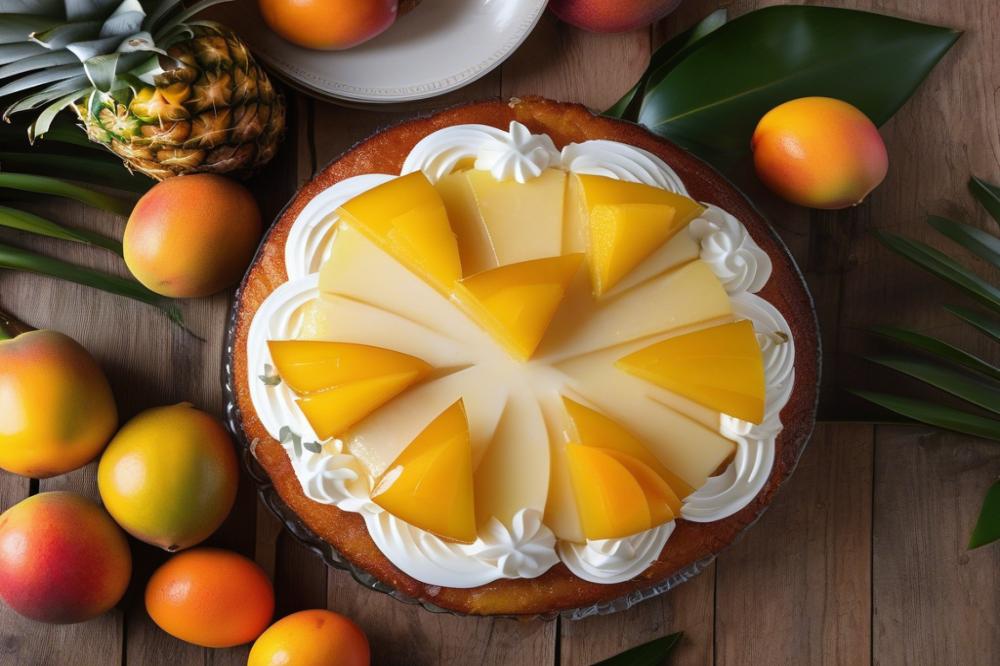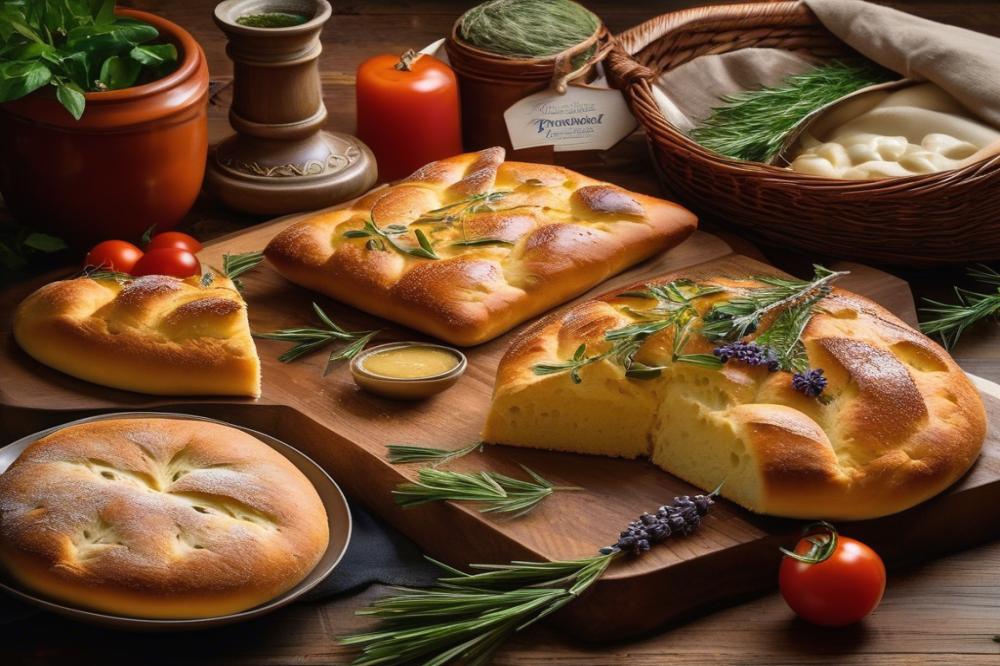Exploring the Delight of Pineapple and Mango Upside-Down Cake
Upside-Down Cakes have a way of drawing people in with their charming presentation. This dessert flips logic on its head, placing vibrant fruits on the bottom before baking. Once inverted, guests are greeted by a beautiful display of caramelized sweetness.
Tropical fruit reigns supreme in many Asian confections. Mango, with its luscious texture and sweet flavor, is often a favorite. Pineapple also shines, bringing its signature tang and juicy goodness. These fruits complement each other wonderfully, making for a delightful pairing in many summer desserts.
Both pineapple and mango add a cheerful brightness to any sweet treat. The combination evokes memories of sun-soaked days and tropical getaways. This enchanting blend leads us to explore a cake recipe that celebrates these flavors in a delicious way. Get ready to dive into the world of fruity desserts as we share the irresistible recipe for Pineapple Mango Upside-Down Cake.
Understanding Upside-Down Cake

Upside-down cake is a type of dessert where the fruit is placed at the bottom of the baking dish. This means when the cake is turned out, the fruit becomes the star of the show, creating an eye-catching presentation. Traditionally, a layer of caramel coats the fruit, adding a luscious sweetness to each bite. The caramelization process gives the cake its signature flavor and texture.
Origins and Variations
This baking technique can be traced back to the mid-19th century, with roots in various cultural cuisines. Asian cooking often features similar concepts, where fruits are layered with sticky rice or rice flour mixtures. These combinations highlight the natural sweetness of tropical fruits in ways that are both flavorful and visually appealing. In Asian desserts, the layering of fruits goes beyond just flavor; it celebrates seasonal produce and local ingredients.
The Importance of Fruit and Caramel
Layering fruits and caramel in these cake recipes creates a delightful contrast in flavor and texture. Juicy fruits like pineapple or mango absorb heat, becoming tender while the sugar caramelizes into a golden syrup. This combination results in moist cake layers that burst with fruity goodness. Using tropical fruit like pineapple and mango adds a refreshing quality, especially in summer desserts.
Spotlight on Pineapple and Mango Cakes
The pineapple upside-down cake is a classic version known for its caramelized rings of pineapple with cherries nestled in the center. It evokes nostalgia and often reminds people of family gatherings. On the other hand, mango cake offers a vibrant twist, celebrating the tropical flavor of mangoes. Both cakes deliver a fruity dessert experience that stands apart from traditional options.
Incorporating these elements into your baking expands the world of sweet treats. Each bite of pineapple or mango cake reveals layers of flavor that dance on the palate. When seeking a delightful and unique addition to summer gatherings, these cakes undoubtedly impress your guests. Fruits not only enhance the taste but also elevate the visual appeal, making them perfect for any occasion.
Ingredients and Quantities

Making a delectable pineapple and mango upside-down cake requires a selection of specific ingredients. Below is a detailed list of what you need along with the quantities to create this tropical fruit treat.
Essential Ingredients
- 1 cup brown sugar
- 1/2 cup unsalted butter (1 stick)
- 1 can (20 oz) of sliced pineapple (in juice)
- 1 to 2 ripe mangoes, peeled and sliced
- 2 cups all-purpose flour
- 1 1/2 teaspoons baking powder
- 1/2 teaspoon baking soda
- 1/4 teaspoon salt
- 3/4 cup granulated sugar
- 2 large eggs
- 1 teaspoon vanilla extract
- 1 cup buttermilk or milk
Choosing the Best Fruits
Selecting fruit at the peak of ripeness helps the flavor shine through. For mangoes, look for a fruit that gives slightly when pressed. The skin should be a mix of green and yellow; avoid overly firm or too soft mangoes. Pineapples should have a sweet aroma and slightly yellowing skin. The leaves on top should pull out easily and not be brown.
Optional Ingredients for Variations
There are many ways to customize this fruity dessert. Using coconut milk instead of regular milk can add a nice flavor. Adding a pinch of cinnamon or nutmeg to the batter offers a warm spice note. You might also try substituting different tropical fruit combinations to suit your taste. For instance, swapping in papaya or passion fruit can add a unique twist. Some bakers even add shredded coconut to the cake layers for extra texture.
Method for Baking

Begin by preheating your oven to 350°F (175°C). This step is essential for getting the right texture in your cake. While the oven warms up, prepare your baking pan. Choose a round, 9-inch cake pan and grease it with a bit of butter. Additionally, sprinkle a layer of brown sugar on the bottom. This will create the caramelized topping.
Caramelizing the Pineapple and Adding Mango
Now, take fresh pineapple and slice it into thin rings. Canned pineapple can also work, but fresh gives a brighter flavor. In a skillet over medium heat, melt 1/2 cup of butter and 1 cup of brown sugar. Stir until the mixture bubbles, creating a rich caramel. Once ready, arrange the pineapple slices in the pan, covering the bottom completely. Add some mango slices around the edges or on top for added flavor and color. The goal is to create a beautiful base for your fruity dessert.
Layering the Fruits
Carefully layer the mango pieces among the pineapple rings. Ensuring an even distribution will enhance the look of your cake layers. Feel free to arrange the fruits in a circular pattern or a more random style, depending on your preference. Sprinkle a few cherries or raisins in the gaps to add contrast and sweetness. The aesthetics are important for this summer dessert.
Baking Time and Temperature Specifications
After the fruit arrangement, prepare your cake batter. Combine flour, sugar, eggs, milk, and baking powder in a mixing bowl. Beat the mixture until it’s smooth. Pour the batter directly over the fruit in the pan. Bake for 40-45 minutes until the top is golden and a toothpick comes out clean. Keep an eye on it to avoid overbaking. Once done, let the cake cool for a few minutes before inverting it onto a serving dish. Enjoy your homemade mango cake, a delightful variation on the classic pineapple upside-down cake!
Serving Suggestions and Pairings
Consider serving pineapple and mango upside-down cake as a delightful dessert after a family dinner. It pairs well with a scoop of vanilla ice cream, which adds creaminess to the fruity dessert. For an extra touch, warm the cake slightly before serving. This method brings out the flavors of the tropical fruit beautifully.
Beverage Pairings
When it comes to beverages, iced tea is a refreshing choice. A sweetened peach tea or a chilled citrus blend complements the flavors of the cake nicely. If you prefer something non-caffeinated, a light, fruity juice could enhance your meal. Freshly squeezed orange juice or a tropical blend with pineapple and mango can create an enjoyable contrast to the sweetness of the cake layers.
Garnishes
Garnishing the cake can elevate its presentation. Sprinkling toasted coconut flakes on top adds texture and a nutty flavor. Fresh mint leaves can be used for a pop of color and freshness. Slices of fresh mango or pineapple can be arranged around the cake for a stunning display. A drizzle of caramel sauce or a dusting of powdered sugar can also enhance its appeal.
Variations for Summer Desserts
Summer is a great time to experiment with different fruit combinations. Consider mixing in slices of ripe peaches or apricots for a seasonal twist. You might also try swapping the mango for berries, like blueberries or strawberries. A berry upside-down version would provide a different but equally delicious taste. Always remember to balance flavors so that no single fruit overwhelms the cake.
For a more exotic dessert, think about adding a hint of coconut milk to your cake recipe. This can create a wonderfully moist texture and a subtle tropical flavor. Additionally, using coconut would make for a great pairing, especially during warmer months when people enjoy sweet treats by the pool or at backyard gatherings.
Troubleshooting Common Issues
Common Problems
Baking upside-down cakes can sometimes lead to unexpected issues. One typical problem is that the cake may end up dense or gummy. This often happens when the batter is overmixed or too much liquid is added. Another issue is the fruit sinking to the bottom. This can make the top uneven and affect presentation. If the cake doesn’t cook evenly, you may notice raw spots or a burnt bottom.
Achieving Perfect Texture and Flavor
Using ripe tropical fruit is key for flavor. Fresh pineapple and mango can elevate the dish. Always chop the fruit into uniform pieces for consistent cooking. For a lighter texture, consider folding in whipped egg whites or using cake flour. Avoid excessive mixing to keep the cake airy. Additionally, using room temperature ingredients often leads to an improved texture.
Avoiding Sogginess and Ensuring Even Cooking
To prevent sogginess, drain excess juice from the fruit. Be mindful of the caramel. Proper measurement helps in balancing sweetness while maintaining cake moisture. Utilize a toothpick to test for doneness in the center. If it comes out clean, you’re good to go. Positioning the cake at the center of the oven promotes even baking.
Storing Leftovers or Freezing
If you have leftover slices, store them in an airtight container. This keeps the cake moist and the flavors intact. For longer-term preservation, freezing is an excellent option. Wrap the pieces tightly in plastic wrap and then place them in a freezer bag. When reheating, allow them to thaw at room temperature before warming in the oven. Thus, you’ll enjoy that delicious dessert again, just like fresh.
Final Thoughts on Baking with Tropical Flavors
Baking a tropical fruit cake brings joy to both the maker and the eater. Pineapple and mango harmonize beautifully, creating a delicious harmony of sweetness. The process of assembling the fruit and batter is straightforward, allowing bakers of all skill levels to enjoy. There’s something particularly satisfying about flipping the cake upside down to reveal a stunning display of vibrant colors and textures.
Don’t hesitate to mix it up with flavors and ingredients. Imagine adding coconut, lime, or even passion fruit to your version. Each substitution can lead to a different twist that excites the taste buds. Creativity in the kitchen yields delightful results. Feel free to explore various combinations that mirror your mood or the season.
This cake serves as a perfect dessert for summer gatherings. Whether it’s a barbecue or a picnic, it’s sure to impress friends and family. The tropical flavors resonate well with warm weather, providing a refreshing end to any meal. Sharing a slice with loved ones makes the experience even more enjoyable.
Readers are encouraged to share their baking experiences with this recipe. What modifications did you try? Did you enjoy the outcome? Your stories can inspire others and create a community of baking enthusiasts. Get ready to dive into your own culinary adventure with this delightful treat!



